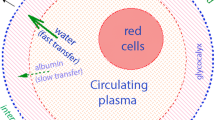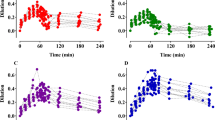Summary
The effects of alterations in the F-cell ratio (i.e., the ratio of the whole body haematocrit to the peripheral haematocrit) on calculations of relative (percentage) change in plasma volume have been considered. Errors introduced by failing to correct the measured haematocrit for an assumed value for the F-cell ratio are small, and are negligible compared with the random measurement errors. Errors introduced by a change in the value of the F-cell ratio from some control value to a new value during an experimental procedure (such as exercise or exposure to heat stress) are large, and could lead to gross misrepresentations of the direction and magnitude of any induced change in intravascular volume, and of solute concentration changes assumed to reflect only loss or gain of fluid by the intravascular space.
Similar content being viewed by others
References
Albert SN, Gravel V, Turmel Y, Albert CA (1965) Pitfalls in blood volume measurement. Anesthesia and Analgesia. Curr Res 44: 805–814
åstrand P-O, Saltin B (1964) Plasma and red cell volume after prolonged severe exercise. J Appl Physiol 19: 829–832
Beaumont W van, Greenleaf JE, Juhos L (1972) Disproportional changes in haematocrit, plasma volume, and proteins during exercise and bed rest. J Appl Physiol. 33: 55–61
Beaumont W van, Underkofler W, Beaumont S van (1981) Erythrocyte volume, plasma volume, and acid-base changes in exercise and heat dehydration. J Appl Physiol: Respirat Environ Exercise Physiol 50: 1255–1262
Chaplin H, Mollison PL (1953) Correction for plasma trapped in the red cell column of the hematocrit. Blood 7: 1227–1238
Chaplin H, Mollison PL, Vetter H (1953) The body/venous hematocrit ratio: its constancy over a wide hematocrit range. J Clin Invest 32: 1309–1316
Cochrane LA, Edwards RJ, Graveney MJ, Harrison MH (1981) Effects of alterations in skin temperature on intravascular volume and protein content in resting subjects. RAF Institute of Aviation Medicine Report No 595
Convertino VA, Greenleaf JE, Bernauer EM (1980) Role of thermal and exercise factors in the mechanism of hypervolemia. J Appl Physiol: Respirat Environ Exercise Physiol 48: 657–664
Costill DL, Saltin B (1974) Changes in the ratio of venous to body hematocrit following dehydration. J Appl Physiol 36: 608–610
Dill DB, Costill DL (1974) Calculation of percentage changes in volumes of blood, plasma and red cells in dehydration. J Appl Physiol 37: 247–248
Ebert RV, Stead EA (1941) Demonstration that in normal man no reserves of blood are mobilised by exercise, epinephrine and haemorrhage. Am J Med Sci 201: 655–664
Elkinton JR, Danowski TS, Winkler AW (1945) Hemodynamic changes in salt depletion and in dehydration. J Clin Invest 25: 120–129
Fricke G von (1965) über das Verhalten den Zellfaktors bei körperlicher Arbeit. Cardiologia 47: 25–44
Garby L, Vuille JG (1961) The amount of trapped plasma in a high speed micro-capillary hematocrit centrifuge. J Clin Lab Invest 13: 642–645
Gibson JG, Seligman AM, Peacock WC, Aub JC, Fine J, Evans RD (1946) The distribution of red cells and plasma in large and minute vessels of the normal dog, determined by radioactive isotopes of iron and iodine. J Clin Invest 25: 848–857
Greenleaf JE, Convertino VA, Stremel RW, Bernauer EM, Adams WC, Vignau SR, Brock PJ (1977) Plasma [Na+], [Ca+2], and volume shifts and thermoregulation during exercise in man. J Appl Physiol: Respirat Environ Exercise Physiol 43: 1026–1032
Greenleaf JE, Convertino VA, Mangseth GR (1979) Plasma volume during stress in man: osmolality and red cell volume. J Appl Physiol: Respirat Environ Exercise Physiol 47: 1031–1038
Gregerson MI, Rawson RA (1959) Blood volume. Physiol Rev 39: 307–342
Harrison MH (1974) Plasma volume changes during acute exposure to high environmental temperature. J Appl Physiol 37: 38–42
Harrison MH, Edwards RJ, Leitch DR (1975) Effects of exercise and thermal stress on plasma volume. J Appl Physiol 39: 925–931
Harrison MH, Edwards RJ, Graveney MJ, Cochrane LA, Davies JA (1981) Blood volume and plasma protein responses to heat acclimatisation in humans. J Appl Physiol: Respirat Environ Exercise Physiol 50: 597–604
Kaltreider NL, Meneely GR (1940) The effect of exercise on the volume of the blood. J Clin Invest 19: 627–634
Nylin G (1947) The effect of heavy muscular work on the volume of circulating red corpuscles in man. Am J Physiol 149: 180–184
Pugh LGCE (1969) Blood volume changes in outdoor exercise of 8–10 hour duration. J Physiol 200: 345–351
Author information
Authors and Affiliations
Rights and permissions
About this article
Cite this article
Harrison, M.H., Graveney, M.J. & Cochrane, L.A. Some sources of error in the calculation of relative change in plasma volume. Europ. J. Appl. Physiol. 50, 13–21 (1982). https://doi.org/10.1007/BF00952240
Accepted:
Issue Date:
DOI: https://doi.org/10.1007/BF00952240




